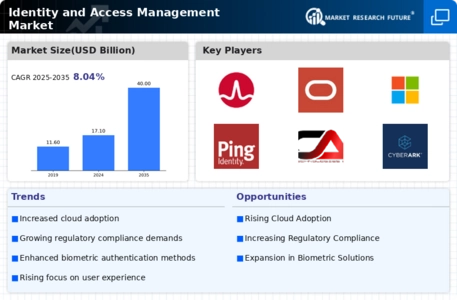On-Premises
Cloud-Based
Hybrid
Single Sign-On
Multi-Factor Authentication
Access Governance
Directory Services
BFSI
Healthcare
Government
IT and Telecom
Retail
Small Enterprises
Medium Enterprises
Large Enterprises
North America
Europe
South America
Asia Pacific
Middle East and Africa
North America Outlook (USD Billion, 2019-2035)
North America Identity and Access Management Market by Deployment Type
On-Premises
Cloud-Based
Hybrid
North America Identity and Access Management Market by Solution Type
Single Sign-On
Multi-Factor Authentication
Access Governance
Directory Services
North America Identity and Access Management Market by End User Type
BFSI
Healthcare
Government
IT and Telecom
Retail
North America Identity and Access Management Market by Organization Size Type
Small Enterprises
Medium Enterprises
Large Enterprises
North America Identity and Access Management Market by Regional Type
US
Canada
US Outlook (USD Billion, 2019-2035)
US Identity and Access Management Market by Deployment Type
On-Premises
Cloud-Based
Hybrid
US Identity and Access Management Market by Solution Type
Single Sign-On
Multi-Factor Authentication
Access Governance
Directory Services
US Identity and Access Management Market by End User Type
BFSI
Healthcare
Government
IT and Telecom
Retail
US Identity and Access Management Market by Organization Size Type
Small Enterprises
Medium Enterprises
Large Enterprises
CANADA Outlook (USD Billion, 2019-2035)
CANADA Identity and Access Management Market by Deployment Type
On-Premises
Cloud-Based
Hybrid
CANADA Identity and Access Management Market by Solution Type
Single Sign-On
Multi-Factor Authentication
Access Governance
Directory Services
CANADA Identity and Access Management Market by End User Type
BFSI
Healthcare
Government
IT and Telecom
Retail
CANADA Identity and Access Management Market by Organization Size Type
Small Enterprises
Medium Enterprises
Large Enterprises
Europe Outlook (USD Billion, 2019-2035)
Europe Identity and Access Management Market by Deployment Type
On-Premises
Cloud-Based
Hybrid
Europe Identity and Access Management Market by Solution Type
Single Sign-On
Multi-Factor Authentication
Access Governance
Directory Services
Europe Identity and Access Management Market by End User Type
BFSI
Healthcare
Government
IT and Telecom
Retail
Europe Identity and Access Management Market by Organization Size Type
Small Enterprises
Medium Enterprises
Large Enterprises
Europe Identity and Access Management Market by Regional Type
Germany
UK
France
Russia
Italy
Spain
Rest of Europe
GERMANY Outlook (USD Billion, 2019-2035)
GERMANY Identity and Access Management Market by Deployment Type
On-Premises
Cloud-Based
Hybrid
GERMANY Identity and Access Management Market by Solution Type
Single Sign-On
Multi-Factor Authentication
Access Governance
Directory Services
GERMANY Identity and Access Management Market by End User Type
BFSI
Healthcare
Government
IT and Telecom
Retail
GERMANY Identity and Access Management Market by Organization Size Type
Small Enterprises
Medium Enterprises
Large Enterprises
UK Outlook (USD Billion, 2019-2035)
UK Identity and Access Management Market by Deployment Type
On-Premises
Cloud-Based
Hybrid
UK Identity and Access Management Market by Solution Type
Single Sign-On
Multi-Factor Authentication
Access Governance
Directory Services
UK Identity and Access Management Market by End User Type
BFSI
Healthcare
Government
IT and Telecom
Retail
UK Identity and Access Management Market by Organization Size Type
Small Enterprises
Medium Enterprises
Large Enterprises
FRANCE Outlook (USD Billion, 2019-2035)
FRANCE Identity and Access Management Market by Deployment Type
On-Premises
Cloud-Based
Hybrid
FRANCE Identity and Access Management Market by Solution Type
Single Sign-On
Multi-Factor Authentication
Access Governance
Directory Services
FRANCE Identity and Access Management Market by End User Type
BFSI
Healthcare
Government
IT and Telecom
Retail
FRANCE Identity and Access Management Market by Organization Size Type
Small Enterprises
Medium Enterprises
Large Enterprises
RUSSIA Outlook (USD Billion, 2019-2035)
RUSSIA Identity and Access Management Market by Deployment Type
On-Premises
Cloud-Based
Hybrid
RUSSIA Identity and Access Management Market by Solution Type
Single Sign-On
Multi-Factor Authentication
Access Governance
Directory Services
RUSSIA Identity and Access Management Market by End User Type
BFSI
Healthcare
Government
IT and Telecom
Retail
RUSSIA Identity and Access Management Market by Organization Size Type
Small Enterprises
Medium Enterprises
Large Enterprises
ITALY Outlook (USD Billion, 2019-2035)
ITALY Identity and Access Management Market by Deployment Type
On-Premises
Cloud-Based
Hybrid
ITALY Identity and Access Management Market by Solution Type
Single Sign-On
Multi-Factor Authentication
Access Governance
Directory Services
ITALY Identity and Access Management Market by End User Type
BFSI
Healthcare
Government
IT and Telecom
Retail
ITALY Identity and Access Management Market by Organization Size Type
Small Enterprises
Medium Enterprises
Large Enterprises
SPAIN Outlook (USD Billion, 2019-2035)
SPAIN Identity and Access Management Market by Deployment Type
On-Premises
Cloud-Based
Hybrid
SPAIN Identity and Access Management Market by Solution Type
Single Sign-On
Multi-Factor Authentication
Access Governance
Directory Services
SPAIN Identity and Access Management Market by End User Type
BFSI
Healthcare
Government
IT and Telecom
Retail
SPAIN Identity and Access Management Market by Organization Size Type
Small Enterprises
Medium Enterprises
Large Enterprises
REST OF EUROPE Outlook (USD Billion, 2019-2035)
REST OF EUROPE Identity and Access Management Market by Deployment Type
On-Premises
Cloud-Based
Hybrid
REST OF EUROPE Identity and Access Management Market by Solution Type
Single Sign-On
Multi-Factor Authentication
Access Governance
Directory Services
REST OF EUROPE Identity and Access Management Market by End User Type
BFSI
Healthcare
Government
IT and Telecom
Retail
REST OF EUROPE Identity and Access Management Market by Organization Size Type
Small Enterprises
Medium Enterprises
Large Enterprises
APAC Outlook (USD Billion, 2019-2035)
APAC Identity and Access Management Market by Deployment Type
On-Premises
Cloud-Based
Hybrid
APAC Identity and Access Management Market by Solution Type
Single Sign-On
Multi-Factor Authentication
Access Governance
Directory Services
APAC Identity and Access Management Market by End User Type
BFSI
Healthcare
Government
IT and Telecom
Retail
APAC Identity and Access Management Market by Organization Size Type
Small Enterprises
Medium Enterprises
Large Enterprises
APAC Identity and Access Management Market by Regional Type
China
India
Japan
South Korea
Malaysia
Thailand
Indonesia
Rest of APAC
CHINA Outlook (USD Billion, 2019-2035)
CHINA Identity and Access Management Market by Deployment Type
On-Premises
Cloud-Based
Hybrid
CHINA Identity and Access Management Market by Solution Type
Single Sign-On
Multi-Factor Authentication
Access Governance
Directory Services
CHINA Identity and Access Management Market by End User Type
BFSI
Healthcare
Government
IT and Telecom
Retail
CHINA Identity and Access Management Market by Organization Size Type
Small Enterprises
Medium Enterprises
Large Enterprises
INDIA Outlook (USD Billion, 2019-2035)
INDIA Identity and Access Management Market by Deployment Type
On-Premises
Cloud-Based
Hybrid
INDIA Identity and Access Management Market by Solution Type
Single Sign-On
Multi-Factor Authentication
Access Governance
Directory Services
INDIA Identity and Access Management Market by End User Type
BFSI
Healthcare
Government
IT and Telecom
Retail
INDIA Identity and Access Management Market by Organization Size Type
Small Enterprises
Medium Enterprises
Large Enterprises
JAPAN Outlook (USD Billion, 2019-2035)
JAPAN Identity and Access Management Market by Deployment Type
On-Premises
Cloud-Based
Hybrid
JAPAN Identity and Access Management Market by Solution Type
Single Sign-On
Multi-Factor Authentication
Access Governance
Directory Services
JAPAN Identity and Access Management Market by End User Type
BFSI
Healthcare
Government
IT and Telecom
Retail
JAPAN Identity and Access Management Market by Organization Size Type
Small Enterprises
Medium Enterprises
Large Enterprises
SOUTH KOREA Outlook (USD Billion, 2019-2035)
SOUTH KOREA Identity and Access Management Market by Deployment Type
On-Premises
Cloud-Based
Hybrid
SOUTH KOREA Identity and Access Management Market by Solution Type
Single Sign-On
Multi-Factor Authentication
Access Governance
Directory Services
SOUTH KOREA Identity and Access Management Market by End User Type
BFSI
Healthcare
Government
IT and Telecom
Retail
SOUTH KOREA Identity and Access Management Market by Organization Size Type
Small Enterprises
Medium Enterprises
Large Enterprises
MALAYSIA Outlook (USD Billion, 2019-2035)
MALAYSIA Identity and Access Management Market by Deployment Type
On-Premises
Cloud-Based
Hybrid
MALAYSIA Identity and Access Management Market by Solution Type
Single Sign-On
Multi-Factor Authentication
Access Governance
Directory Services
MALAYSIA Identity and Access Management Market by End User Type
BFSI
Healthcare
Government
IT and Telecom
Retail
MALAYSIA Identity and Access Management Market by Organization Size Type
Small Enterprises
Medium Enterprises
Large Enterprises
THAILAND Outlook (USD Billion, 2019-2035)
THAILAND Identity and Access Management Market by Deployment Type
On-Premises
Cloud-Based
Hybrid
THAILAND Identity and Access Management Market by Solution Type
Single Sign-On
Multi-Factor Authentication
Access Governance
Directory Services
THAILAND Identity and Access Management Market by End User Type
BFSI
Healthcare
Government
IT and Telecom
Retail
THAILAND Identity and Access Management Market by Organization Size Type
Small Enterprises
Medium Enterprises
Large Enterprises
INDONESIA Outlook (USD Billion, 2019-2035)
INDONESIA Identity and Access Management Market by Deployment Type
On-Premises
Cloud-Based
Hybrid
INDONESIA Identity and Access Management Market by Solution Type
Single Sign-On
Multi-Factor Authentication
Access Governance
Directory Services
INDONESIA Identity and Access Management Market by End User Type
BFSI
Healthcare
Government
IT and Telecom
Retail
INDONESIA Identity and Access Management Market by Organization Size Type
Small Enterprises
Medium Enterprises
Large Enterprises
REST OF APAC Outlook (USD Billion, 2019-2035)
REST OF APAC Identity and Access Management Market by Deployment Type
On-Premises
Cloud-Based
Hybrid
REST OF APAC Identity and Access Management Market by Solution Type
Single Sign-On
Multi-Factor Authentication
Access Governance
Directory Services
REST OF APAC Identity and Access Management Market by End User Type
BFSI
Healthcare
Government
IT and Telecom
Retail
REST OF APAC Identity and Access Management Market by Organization Size Type
Small Enterprises
Medium Enterprises
Large Enterprises
South America Outlook (USD Billion, 2019-2035)
South America Identity and Access Management Market by Deployment Type
On-Premises
Cloud-Based
Hybrid
South America Identity and Access Management Market by Solution Type
Single Sign-On
Multi-Factor Authentication
Access Governance
Directory Services
South America Identity and Access Management Market by End User Type
BFSI
Healthcare
Government
IT and Telecom
Retail
South America Identity and Access Management Market by Organization Size Type
Small Enterprises
Medium Enterprises
Large Enterprises
South America Identity and Access Management Market by Regional Type
Brazil
Mexico
Argentina
Rest of South America
BRAZIL Outlook (USD Billion, 2019-2035)
BRAZIL Identity and Access Management Market by Deployment Type
On-Premises
Cloud-Based
Hybrid
BRAZIL Identity and Access Management Market by Solution Type
Single Sign-On
Multi-Factor Authentication
Access Governance
Directory Services
BRAZIL Identity and Access Management Market by End User Type
BFSI
Healthcare
Government
IT and Telecom
Retail
BRAZIL Identity and Access Management Market by Organization Size Type
Small Enterprises
Medium Enterprises
Large Enterprises
MEXICO Outlook (USD Billion, 2019-2035)
MEXICO Identity and Access Management Market by Deployment Type
On-Premises
Cloud-Based
Hybrid
MEXICO Identity and Access Management Market by Solution Type
Single Sign-On
Multi-Factor Authentication
Access Governance
Directory Services
MEXICO Identity and Access Management Market by End User Type
BFSI
Healthcare
Government
IT and Telecom
Retail
MEXICO Identity and Access Management Market by Organization Size Type
Small Enterprises
Medium Enterprises
Large Enterprises
ARGENTINA Outlook (USD Billion, 2019-2035)
ARGENTINA Identity and Access Management Market by Deployment Type
On-Premises
Cloud-Based
Hybrid
ARGENTINA Identity and Access Management Market by Solution Type
Single Sign-On
Multi-Factor Authentication
Access Governance
Directory Services
ARGENTINA Identity and Access Management Market by End User Type
BFSI
Healthcare
Government
IT and Telecom
Retail
ARGENTINA Identity and Access Management Market by Organization Size Type
Small Enterprises
Medium Enterprises
Large Enterprises
REST OF SOUTH AMERICA Outlook (USD Billion, 2019-2035)
REST OF SOUTH AMERICA Identity and Access Management Market by Deployment Type
On-Premises
Cloud-Based
Hybrid
REST OF SOUTH AMERICA Identity and Access Management Market by Solution Type
Single Sign-On
Multi-Factor Authentication
Access Governance
Directory Services
REST OF SOUTH AMERICA Identity and Access Management Market by End User Type
BFSI
Healthcare
Government
IT and Telecom
Retail
REST OF SOUTH AMERICA Identity and Access Management Market by Organization Size Type
Small Enterprises
Medium Enterprises
Large Enterprises
MEA Outlook (USD Billion, 2019-2035)
MEA Identity and Access Management Market by Deployment Type
On-Premises
Cloud-Based
Hybrid
MEA Identity and Access Management Market by Solution Type
Single Sign-On
Multi-Factor Authentication
Access Governance
Directory Services
MEA Identity and Access Management Market by End User Type
BFSI
Healthcare
Government
IT and Telecom
Retail
MEA Identity and Access Management Market by Organization Size Type
Small Enterprises
Medium Enterprises
Large Enterprises
MEA Identity and Access Management Market by Regional Type
GCC Countries
South Africa
Rest of MEA
GCC COUNTRIES Outlook (USD Billion, 2019-2035)
GCC COUNTRIES Identity and Access Management Market by Deployment Type
On-Premises
Cloud-Based
Hybrid
GCC COUNTRIES Identity and Access Management Market by Solution Type
Single Sign-On
Multi-Factor Authentication
Access Governance
Directory Services
GCC COUNTRIES Identity and Access Management Market by End User Type
BFSI
Healthcare
Government
IT and Telecom
Retail
GCC COUNTRIES Identity and Access Management Market by Organization Size Type
Small Enterprises
Medium Enterprises
Large Enterprises
SOUTH AFRICA Outlook (USD Billion, 2019-2035)
SOUTH AFRICA Identity and Access Management Market by Deployment Type
On-Premises
Cloud-Based
Hybrid
SOUTH AFRICA Identity and Access Management Market by Solution Type
Single Sign-On
Multi-Factor Authentication
Access Governance
Directory Services
SOUTH AFRICA Identity and Access Management Market by End User Type
BFSI
Healthcare
Government
IT and Telecom
Retail
SOUTH AFRICA Identity and Access Management Market by Organization Size Type
Small Enterprises
Medium Enterprises
Large Enterprises
REST OF MEA Outlook (USD Billion, 2019-2035)
REST OF MEA Identity and Access Management Market by Deployment Type
On-Premises
Cloud-Based
Hybrid
REST OF MEA Identity and Access Management Market by Solution Type
Single Sign-On
Multi-Factor Authentication
Access Governance
Directory Services
REST OF MEA Identity and Access Management Market by End User Type
BFSI
Healthcare
Government
IT and Telecom
Retail
REST OF MEA Identity and Access Management Market by Organization Size Type
Small Enterprises
Medium Enterprises
Large Enterprises

















Leave a Comment